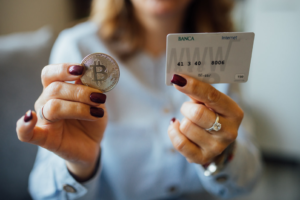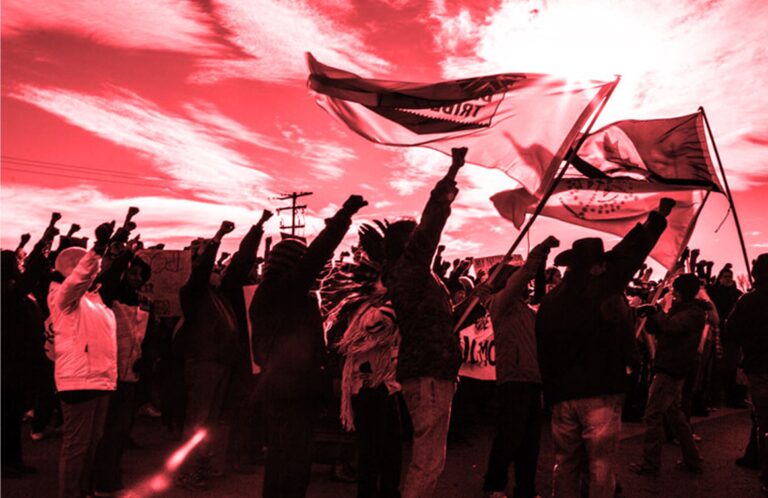In January 2022 a small convoy of trucks left Prince Rupert, B.C. for Ottawa. They were upset about Covid-19 vaccine mandates the federal government had recently imposed on cross-border long-haul truckers and wanted to make sure the country’s politicians understood their concerns. By the end of the month about 3,000 trucks and cars and over 15,000 protesters had converged on Canada’s capital under the “Freedom Convoy” banner.

Local, provincial and federal governments immediately and loudly complained about the strain this peaceful protest imposed on public services. Inside the protest movement, however, the problem was converting a tidal wave of public support into usable financial aid for individual truckers. Organizers had initially launched a single fundraising campaign on GoFundMe, a commonly-used crowdfunding platform, with the goal of raising some money to pay for the protesters’ diesel fuel and other basic supplies. By the end of January, they’d collected $4 million from more than 100,000 sympathetic donors. This would soon climb to $10 million. Donations on another platform, GiveSendGo, collected $8.5 million more. In all, nearly $25 million was raised across a variety of crowdfunding outlets for the protesters. Additional unknown amounts were also donated in cash. All without any central organizing effort.
Such ebullient and spontaneous public support for the Freedom Convoy was met with swift government concern and rebuke. On February 3, GoFundMe’s management team was questioned by a House of Commons committee about the source and nature of the donations raised. The next day, amid intense political scrutiny, the platform delisted the campaign. Then on February 10, the Ontario Superior Court of Justice granted the province a court order to stop fundraising on the GiveSendGo platform.
Almost all the money raised from the various dollar-denominated crowdfunding websites to support the protest was prevented from reaching the truckers by government action or threat.
One week later, the federal government invoked the Emergencies Act for the first time, giving itself unprecedented financial powers to quell the protest in many other ways. Hundreds of bank accounts, including personal, business and mutual fund holdings, were ordered frozen by Ottawa. Rather than defending their duty of care to their customers, Canada’s chartered banks meekly complied with the order. “We now have the tools to follow the money. We can see what is happening and what is being planned in real time,” Deputy Prime Minister Chrystia Freeland declared at an Ottawa press conference announcing the extraordinary legal measures. Adopting the sternest possible visage, she declared, “Do not doubt our determination to act.”
And act she did. According to a report from the federal Public Order Emergency Commission, also known as the Rouleau Commission, almost all the money raised from the various dollar-denominated crowdfunding websites to support the protest was prevented from reaching the truckers by government action or threat. As the colourful accompanying flow chart illustrates, the bulk of this money was either returned to donors or is still sitting in escrow awaiting the outcome of various lawsuits. It is possible some small portion of donated cash (follow the blue, yellow and tan lines on the chart’s left side) did make it to the protesters, but that appears to be minimal.
 “Do not doubt our determination to act”: On February 17, 2022, a stern-faced Deputy Prime Minister Chrystia Freeland announced her intention to use the Emergencies Act to freeze the bank accounts of protesters (and possibly supporters) and to seize donated funds. (Source of photo: The Canadian Press/Adrian Wyld)
“Do not doubt our determination to act”: On February 17, 2022, a stern-faced Deputy Prime Minister Chrystia Freeland announced her intention to use the Emergencies Act to freeze the bank accounts of protesters (and possibly supporters) and to seize donated funds. (Source of photo: The Canadian Press/Adrian Wyld)As this was going on, convoy leader Nicholas St. Louis, also known by his online call sign NobodyCaribou, was experimenting with another form of fundraising. In late January, St. Louis created “HonkHonk Hodl” on the Tallycoin platform. Tallycoin differs from GoFundMe and GiveSendGo in that donors provide Bitcoin cryptocurrency rather than Canadian dollars when making a donation. HonkHonk Hodl quickly raised almost 22 Bitcoin, or more than $1 million.
 Follow the digital paths: This chart from the Rouleau Commission shows the fate of donations raised electronically via crowdfunding platforms during the Freedom Convoy protests. The blue, tan and yellow lines depict how the GiveSendGo and GoFundMe donations were frozen but ultimately returned to donors (green lines in centre) or remain in escrow (pink and orange lines at upper right). Only the HonkHonk Hodl Bitcoin campaign (orange line at lower left) was able to get a substantial portion of its money to the truckers (blue line at lower right). In addition, unknown amounts were raised in cash and distributed. (Source of graphic: Rouleau Commission)
Follow the digital paths: This chart from the Rouleau Commission shows the fate of donations raised electronically via crowdfunding platforms during the Freedom Convoy protests. The blue, tan and yellow lines depict how the GiveSendGo and GoFundMe donations were frozen but ultimately returned to donors (green lines in centre) or remain in escrow (pink and orange lines at upper right). Only the HonkHonk Hodl Bitcoin campaign (orange line at lower left) was able to get a substantial portion of its money to the truckers (blue line at lower right). In addition, unknown amounts were raised in cash and distributed. (Source of graphic: Rouleau Commission)And while Canadian authorities moved against this funding source with the same alacrity and hammer-like intensity they displayed with the dollar-denominated fundraising sites, St. Louis was far more successful in distributing the money he raised to its intended recipients. According to the Rouleau Report, he managed to distribute 14.6 Bitcoin, or approximately $800,000, to the truckers. The remaining 6.7 Bitcoin, or less than $300,000, was eventually seized by police. (Note how the bulk of the left-hand orange line flows into the blue “Available to protestors” line on the chart’s right side.)
As a recent documentary by the Reason Foundation explains, “Financial censorship, or cutting off access to the global banking system, is one of the most powerful tools that governments have for punishing people.” The actions of Prime Minister Justin Trudeau government’s during the convoy certainly meet the definition of financial censorship. Virtually anyone who tried to make a donation in Canadian legal tender via electronic means found their efforts ultimately stymied. At the same time, St. Louis’ experience with Bitcoin suggests that cryptocurrencies may offer far greater personal privacy and, accordingly, stronger resistance to interference by third parties – including governments intent on exercising politically motivated financial censorship.
Here is what you need to know about how it happened. And why Ottawa wants to make sure it never happens again.
Bitcoin for Beginners
The world’s first cryptocurrency was created by an unknown person or group under the pseudonym Satoshi Nakamoto in 2009. “What is needed is an electronic payment system based on cryptographic proof instead of trust, allowing any two willing parties to transact directly with each other without the need for a trusted third party,” Satoshi wrote in the seminal document Bitcoin: A Peer-to-Peer Electronic Cash System.
Bitcoin and newer cryptocurrencies such as Ethereum, Litecoin or Dogecoin rely on a foundational technology called blockchain. This is effectively a digital ledger, similar to the records of a banking statement, that allows a digital currency to fulfill the role of traditional money by acting as a unit of exchange. The necessary security is provided through advanced encryption – conversion of all data from a readable into an encoded form – hence the “crypto” in cryptocurrencies.

Blockchain has two key features. First, unlike traditional centralized databases, it exists on many computers, or nodes, around the globe. In this way it cannot be shut down; no single entity has control over it. Second, it is immutable. Every time a transaction occurs, it is recorded in an ever-lengthening chain of information blocks that cannot be tampered with. This chaining is done through a “consensus mechanism,” which verifies the validity and security of any transaction. Unlike traditional currencies issued by governments, the consensus mechanism operates without the need for a trusted intermediary, such as a bank, to oversee the process.
Since Bitcoins are electronic, they can reside in a trading platform similar to how stocks and bonds are bought and sold. They can also be held in a crypto “wallet.” A crypto wallet is simply a place that holds the private digital key (similar to a login ID and password) necessary to access and manage a user’s cryptocurrency. While this wallet can be digital, it can also be as rudimentary as a piece of paper printed with the key, or a “seed phrase” – 25 random words that can be used to recover the key. A wallet can also be a special physical device with sophisticated tamper-proof security features, or a digital application (either online or locally installed) that holds the key and is used to interact with the cryptocurrency.
Another important aspect of cryptocurrencies is how they are created. Bitcoins are “mined” rather than minted or printed. Bitcoin miners compete with each other to solve the complex cryptography problems required to maintain the consensus mechanism, and are rewarded for their effort with new Bitcoin. Anyone can become a miner, as long as he or she has the necessary computer hardware and a data centre with a sufficiently robust air conditioning system to deal with the heat generated by all that computing effort. Financial success in mining thus becomes a race between the Bitcoin the miner earns and their electricity bill.
How to Seize Crypto – Simple and Advanced Techniques
If you hold your Bitcoin in a trading platform or online application wallet, your wallet is technically controlled by the third party that manages that platform or app. This unfortunately means a government can issue an order that the funds be blocked or transferred to another, government-controlled wallet address. In this sense, Bitcoin is no different from funds held in ordinary bank accounts or on the crowdfunding platforms Ottawa froze during last year’s imposition of the Emergencies Act.
‘Officers forcibly removed me from my apartment and took me to an unmarked police vehicle,’ St. Louis said in court filing. ‘Police wanted the seed phrases for my crypto wallets. Under police compulsion I provided my seed phrases.’
It is, however, much more difficult to take over wallets that entail physical possession of the keys. It was this feature that allowed St. Louis to distribute $8,000 each to 100 truckers between February 15 and 17 in Ottawa. As he explained on Twitter, St. Louis went from truck to truck handing out brown envelopes containing the seed phrases of the individual wallets as well as printed instructions for how each trucker could access their share of the donated Bitcoin using their cellphone. It was a powerful demonstration of Bitcoin’s ability to enable transactions between individuals without government control in specific circumstances.
As St. Louis was completing his trucker door-to-door giveaway, however, a lawsuit targeting Freedom Convoy participants won a rare “Mareva injunction” in court. This is a legal order typically used in cases of serious financial criminality that grants authorities the ability to freeze certain assets – in this instance, any Bitcoin associated with the convoy. As a result, convoy organizers were forced to disclose their wallets to police. “Officers forcibly removed me from my apartment and took me to an unmarked police vehicle,” St. Louis said in court filing. “Police wanted the seed phrases for my crypto wallets. Under police compulsion I provided my seed phrases.”

Heavy-handed, knock-on-the-door techniques are not a government’s only option for seizing Bitcoins. Since regulators and other authorities control the interface points where cryptocurrencies can be traded for goods or other currencies, they can simply forbid these sites from accepting payment originating from certain wallets, leaving the Bitcoin stranded.
They can also publish lists of seized wallet addresses and declare that anyone who accepts seized Bitcoins in exchange for goods, cash or other crypto will be charged with money laundering. The Mareva injunction, for example, restricted moving Bitcoins into bank accounts associated with the wallet addresses named in the suit. And because most cryptocurrencies, including Bitcoin, have transparent rather than confidential blockchains, transactions can be verified and/or traced by anyone in the world. This also means the addresses associated with these transactions can ultimately be linked to real-world identities. Despite their allegedly anonymous nature, every Bitcoin transaction can theoretically be subject to official scrutiny.
As a result of all these government options, it remains unclear how much of the $800,000 worth of Bitcoin St. Louis distributed to the truckers in February was tracked and seized, or successfully converted by its recipients into goods or cash. We can hope.
Defeating Financial Censorship
Not all cryptocurrencies are created equal, particularly when it comes to “fungibility.” This term refers to the ability of a commodity or currency to retain its value in all circumstances, as well as being seamlessly interchangeable and indistinguishable from other units of the same item. All $10 bills, for example, are the same, and will always buy $10 worth of stuff. But the fungibility of Bitcoin can change with the traceability of the wallet that holds it. A “dirty” wallet, in other words, can tarnish the value of the Bitcoin it holds. To use an analogy, this is why kidnappers (at least in the movies) always demand that a ransom be paid in small, unmarked, non-consecutive bills. Knowing that cash can be traced lowers its value. The same holds true for digital currency.
With political dissent treated more and more like criminal activity – remember, all of the allegations of violence made about the Freedom Convoy crumbled under scrutiny – we can expect more cases like the de-banking of Nigel Farage.
To solve this problem, there are “mixing” services that can obscure the paths of Bitcoin wallets, allowing “marked” Bitcoins to be moved into clean wallets. The procedure is quite tedious, however, and the mixing services are not free. There’s also a subcategory of cryptocurrencies usually called privacy coins which are fully fungible, meaning they cannot be tarnished by the history of the wallets they have visited. Dash is one such option, but it only offers enhanced privacy for an extra fee. Another option, Monero, is hampered by its reputation for being popular with criminals – which might be considered an endorsement of sorts. Zcash is a newer option that appears to be the most anonymous, although its newness means it is correspondingly less popular.
 The world we’re living in: Like the demands of Hollywood kidnappers for small unmarked bills, “privacy” crypto-coins and “mixing” services can foil efforts to trace and interfere with cryptocurrency transactions. Shown, a scene from the 1996 movie Ransom starring Mel Gibson as he responds to his son’s kidnappers’ ransom demand. (Source of photo: IMDB, retrieved from Critics At Large)
The world we’re living in: Like the demands of Hollywood kidnappers for small unmarked bills, “privacy” crypto-coins and “mixing” services can foil efforts to trace and interfere with cryptocurrency transactions. Shown, a scene from the 1996 movie Ransom starring Mel Gibson as he responds to his son’s kidnappers’ ransom demand. (Source of photo: IMDB, retrieved from Critics At Large)And while privacy coins may be linked to criminal activity (as is cash), there are plenty of legitimate reasons for wanting to keep your financial transactions anonymous. This can include paying for private medical procedures or psychotherapy, donations to charities, preventing advertisers from collecting your personal details, keeping your net worth hidden from prying eyes and preventing hackers from accessing your information. The list goes on. Unfortunately, the list of reasons now appears to include citizens of democracies protecting themselves against political persecution.
One chilling recent example is UK politician Nigel Farage’s ordeal of “de-banking,” which underscores the importance of personal privacy and the ways in which one’s own name and activity can provoke financial censorship. Farage, a prominent “Euroskeptic” and vocal leader of the Brexit movement, recently had his accounts closed by banker Coutts & Co, where he had been a client in good standing since 1980.
An internal report by Coutts, however, cited him as a “reputational risk” and he was promptly tossed out the door. The ludicrous “evidence” amassed against Farage in this report included his outspoken political views (shared, in the case of Brexit, by the majority of British voters) and friendship with former U.S. President Donald Trump. Only after a public and political outcry did Coutts apologize and offer to reinstate Farage’s accounts. Similar accusations have been made against U.S. bank JPMorgan Chase by American religious groups which also claim they have been de-banked for their political views.

With political dissent treated more and more like criminal activity – remember, all of the allegations of violence made about the Freedom Convoy crumbled under scrutiny – we can expect more cases like that of Farage and the truckers. And that suggests more people will want to explore alternative means of conducting their financial transactions away from government and institutional oversight. A desire to live without constant surveillance while retaining the conveniences of modern life means privacy coins and other crypto innovations will likely have growing appeal for tech-savvy people.
As for the best way to distribute Bitcoin donations to the Freedom Convoy, hindsight suggests a mixing service or privacy coins would have been a better choice for keeping the money away from the grasping hand of government. But pressed for time and breaking new ground, St. Louis reached out to J.W. Weatherman, a Bitcoin developer, who helped him create the paper envelope process. Their resulting document, “Step-By-Step Guide For Distributing Bitcoin” explains the system behind the distribution of the $800,000 in donations to the truckers and serves as a useful beginner’s tutorial on good privacy practices as well as the safe and anonymous use of the Internet and cryptocurrencies.
Central Banks Want In
Amidst all the innovations in cryptocurrency driven by private effort, governments have recently shown great interest in creating their own blockchain-like technologies through what is called a central bank digital currency (CBDC). According to the Atlantic Council, a NATO-aligned think-tank, the number of countries investigating a CBDC has grown rapidly. Pre-Covid-19 there were just 35 countries involved. Today 130 have explored the concept to some degree. Nearly all G20 countries are currently in some stage of developing or implementing a CBDC. This includes 11 extant government-controlled digital currencies. China, for example, has a pilot program covering over 260 million people which allows transactions for public transit, stimulus payments and e-commerce. Russia’s CBDC, or “digital ruble,” went into action last month as an optional currency for every citizen of the Russian Federation.

In 2016, the Bank of Canada launched Project Jasper to explore the use of a digital payment scheme for wholesale interbank transactions in this country. The foundational technology for this somewhat mysterious project is not blockchain in the usual sense, but what is called a Distributed Ledger Technology platform developed by a private company, R3. While the Jasper research project hasn’t officially concluded, no published updates have appeared since 2018.
The apparent lack of progress might be explained by the Bank of Canada’s recent shift away from a wholesale CBDC, where there are significant problems left to solve, to the retail sector, which is closer to the consumer. In 2020, the Bank announced it was planning to “build the capacity to issue a general purpose, cash-like CBDC should the need to implement one arise.” And earlier this year, the Bank of Canada launched online public consultations on the features Canadians might want from a digital Canadian dollar. The consultations closed in June, however, after only two months, and its results have not been published.

Beyond its vaguely political-sounding claim of “promoting financial inclusion,” the Bank asserts that a retail-level CBDC may become necessary due to the trend towards cashless transactions. But Canadians already make prodigious use of many forms of digital money. This includes credit cards, debit cards, prepaid cards and mobile applications such as PayPal or Cash App. Plus, all financial institutions offer a wide variety of online services and mobile applications covering everything from opening bank accounts, to paying bills and e-mailing funds, to applying for mortgages. Money is widely available in digital form across Canada, and the Bank of Canada plays little direct role in making all this happen. Significantly, all this digital money is easily convertible back into paper money whenever its holder wishes.
Problems Aplenty
Last year the UK’s House of Lords Economic Affairs Committee released a provocative and prescient paper on the issue of creating a retail CBDC in that country, entitled Central bank digital currencies: A solution in search of a problem? As the committee concluded, “We have yet to hear a convincing case for why the UK needs a retail CBDC. While a CBDC may provide some advantages, it could present significant challenges for financial stability and the protection of privacy.”
Curiously enough, this is the same general conclusion reached by a recently-released analysis from the Bank of Canada. The report, Unmet Payment Needs and a Central Bank Digital Currency, observed a lack of obvious need to justify creating a CBDC in Canada. “Most consumers face few payment gaps or frictions and therefore might have relatively weak incentives to adopt and – especially – to use CBDC at scale,” it stated. But if that is the case, why then does the Bank still appear to be forging ahead?
With a CBDC, the consensus mechanism is not democratically distributed but is held within a set of government agencies. Hence it shares none of the permission-less, lack-of-a-central-validator qualities of cryptocurrency.
One explanation may lie in an issue with more relevance to the Bank of Canada’s own sense of purpose than the retail needs of Canadians: the alleged need to counter the spontaneous proliferation of privately-created cryptocurrencies. “It’s also possible that private cryptocurrencies or central bank digital currencies issued by other countries could become widely used in Canada in the future,” the Bank’s May 2023 release stated. “This could compromise the role of an official, centrally issued currency – the Canadian dollar – in our economy and pose a risk to the stability of our financial system.”

This suggests the Bank of Canada considers a possible CBDC as a replacement for Bitcoin and the other cryptocurrencies that are threatening its position in Canada’s monetary system. But while the underpinnings of the two technologies can be very similar, conflating the two is seriously misleading. Even if a CBDC adopts blockchain at the design level (China’s e-CNY, for example, does not) the differences in implementation and management are substantial. With a CBDC, the consensus mechanism is not democratically distributed but is held within a set of government agencies. Hence it shares none of the permission-less, lack-of-a-central-validator qualities of cryptocurrencies. And while a government may attempt to position a CBDC as a stable, officially-sanctioned alternative to volatile cryptocurrencies, doing so requires giving up the (admittedly limited) privacy aspects of Bitcoin et al.
Further, as the new currency of the realm, a CBDC would become a liability of the central bank itself. Unlike now, when your bank or credit card institution is liable for your respective transactions, with a CBDC a government agency would have the direct responsibility to hold, transfer or remit those funds to you and those with whom you do business. Such a setup creates a clear and unbreakable link between citizens and their central bank.
With a CBDC operating as an arm of the federal government, and offering Bitcoin-like transparency to that same government, financial privacy and personal sovereignty will become a thing of the past. And this opens the door to vast additional government oversight and control. Had HonkHonk Hodl donors been required to make their contributions with a Canadian CBDC instead of Bitcoin, it’s all-but-certain none of that money would have made it to the truckers.

A government-controlled digital currency would make it possible for all political dissidents to be treated in the same contemptuous fashion as Farage and the truckers. Such behaviour would become even easier, in fact, since it would no longer be necessary to compel action by intermediaries like banks or crowdfunding platforms. And because it is digital and centrally-controlled, a CBDC’s value is technically programmable. This means it could be used to prefer or reject certain consumption or social behaviour. It could also theoretically be used to enforce future pandemic lockdowns by limiting individuals’ access to their CBDC wallets to certain physical locations.
Further, because it will presumably become impossible to convert this digital fiat money back into physical cash, there will be no way around such orders. It might even be possible to automate this entire process using AI bots that sweep social media platforms such as Meta and X to decide who has earned the right to use a CBDC wallet and who has not. It seems a control-minded government’s fever-dream.
As the Bank of Canada readily admits, Canadians have no need for a government-run digital currency. Governments may have other ideas. Privacy-minded and freedom-loving people should beware. And be informed.
Gleb Lisikh is a researcher and IT management professional, and a father of three children. He lives in Vaughan, Ontario and grew up in various parts of the Soviet Union.
Source of main image: Shutterstock.






